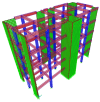On the Cementitious Mixtures Reinforced with Waste Polyethylene Terephthalate
- PMID: 39517622
- PMCID: PMC11547631
- DOI: 10.3390/ma17215351
On the Cementitious Mixtures Reinforced with Waste Polyethylene Terephthalate
Abstract
The last decade was dominated by a serious problem that now affects all the planet's natural ecosystems: the increasing growth of plastics and microplastics that are difficult to dispose of. One strategy to mitigate this problem is to close the life cycle of one of them-polyethylene terephthalate (PET)-by reusing it within the most common building materials, such as mortars and concretes. The reuse of PET waste as aggregates also allows us to limit the CO2 emissions released during the production of natural aggregates. This paper analyzes the outcomes of many studies carried out on the characteristics of cementitious mixtures reinforced with waste PET material. Many researchers have demonstrated how PET used as reinforcement of mortars and concretes can produce an increase in the mechanical strengths of the corresponding cementitious mixtures without PET. The tensile strength of this resin is higher than that of concrete; so, by combining the two materials it is possible to obtain a mixture with an overall higher tensile strength, resulting in increased flexural strength and reduced cracking. Using an effective size of PET fibers, it is possible to achieve an increase in the ductility and toughness of the cementitious mixture. Several studies reveal that PET reinforcement reduces the density with a consequent decrease in weight and structural loads, while the workability increases using spherical and smoother PET aggregates.
Keywords: PET fibers and aggregates; PET-reinforced cementitious mixtures; concrete; mortar; recycling; strengthened mechanical properties.
Conflict of interest statement
The authors declare no conflicts of interest.
Figures












References
-
- UNEP . The State of Plastics World Environment Day Outlook. Oxford University Press; Oxford, UK: 2018.
-
- Singh N., Hui D., Singh R., Ahuja I.P.S., Feo L., Fraternali F. Recycling of Plastic Solid Waste: A State of Art Review and Future Applications. Compos. B Eng. 2017;115:409–422. doi: 10.1016/j.compositesb.2016.09.013. - DOI
-
- Arulrajah A., Perera S., Wong Y.C., Horpibulsuk S., Maghool F. Stiffness and Flexural Strength Evaluation of Cement Stabilized PET Blends with Demolition Wastes. Constr. Build. Mater. 2020;239:117819. doi: 10.1016/j.conbuildmat.2019.117819. - DOI
-
- Coviello C.G., Lassandro P., Sabbà M.F., Foti D. Mechanical and Thermal Effects of Using Fine Recycled PET Aggregates in Common Screeds. Sustainability. 2023;15:16692. doi: 10.3390/su152416692. - DOI
Publication types
LinkOut - more resources
Full Text Sources

